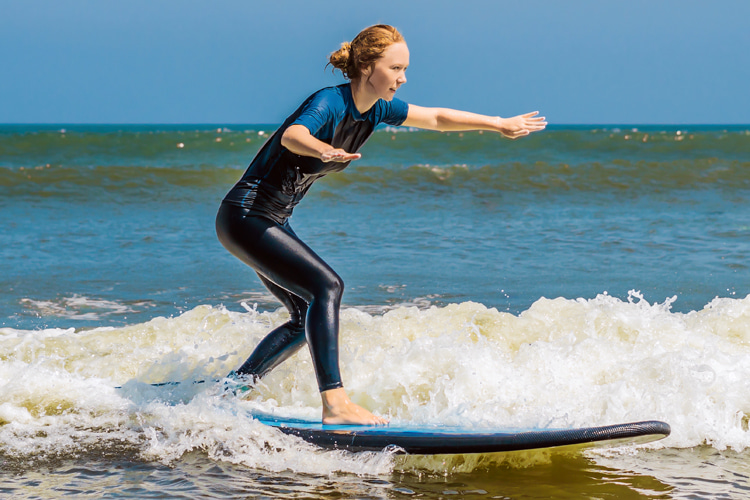You've learned how to paddle a surfboard. So, what's next? The next step is to spend a week, or at least a few days, learning to surf in the whitewater.
"Riding the soup" at a surfing area conducive to learning is the fastest way of getting up on a surfboard for the first time.
But before we continue, you will need a detailed explanation of different types of waves and how to recognize good beginner whitewater waves for learning.
A beach break is one of the three main classifications of wave types with specific shore bottom configurations that cause surfable waves.
The other two are reef breaks and point breaks.
Surfable ocean waves usually fall into one of these three main categories.
But there are other less common types of wave configurations that can be caused by jetties, groins and piers, reef passes, and harbor entrances.
A beach break is a sand bottom wave where the beach is usually, but not always, a sandy shoreline.
A reef break, as the name implies, is a reef bottom wave that usually, but not always, breaks in front of a rocky shoreline.
A reef can be comprised of any bottom other than sand that causes waves to break.
Surfable reef waves peel or angle into a channel where the water is deeper than where the reef is.
There are solid rock reefs, coral reefs, boulder reefs, and, less commonly, accidental artificial reefs caused by sunken boats, barges, or ships, old beach structures, and designed artificial reefs made of concrete, steel rebar, glass, or other materials.
A point break is a wave that wraps around a protruding headland where the bottom is usually, but not always, a mixture of reef and sand.
There are also pure sand-bottom points and reef points. Another type of wave related to the point break is a cove break.
Most point breaks have a portion or section of the wave that breaks into a cove, but there are also waves that break into standalone coves that aren't part of any point break.
And there are some point breaks that don't break into a cove at all.
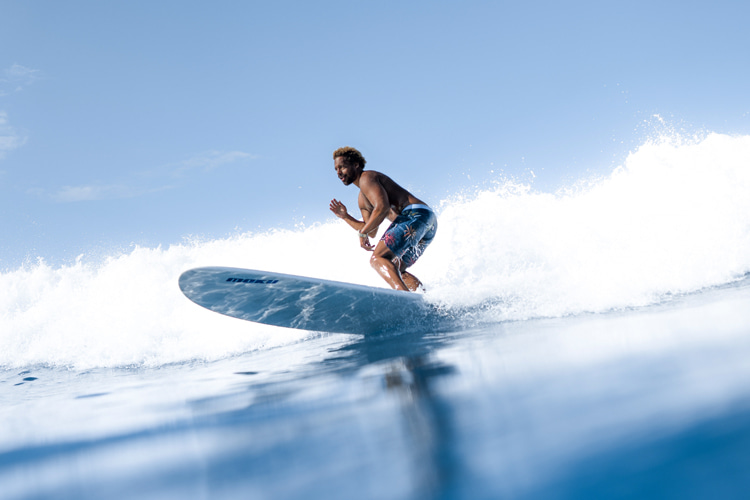
Whitewater Rollers
A beach break with whitewater going all the way to a sandy beach is usually ideal for learning.
There are exceptions, depending on the place, like Waikiki in Hawaii, for instance, which has a bottom that combines reef and sand.
But most surfing zones in the world have areas considered to be suitable for beginners.
And most surf spots that are good for beginners, including Waikiki, have whitewater rolling in.
That's what you want to look for after you master paddling your surfboard in flat water.
Whitewater, otherwise known as the soup, is the aftermath of a broken wave that the swell continues pushing toward shore after the wave's initial crash.
The standing up and crashing of the wave can take a few seconds - sometimes, it's over in an instant.
The wave can peel or angle as it breaks over a long distance, but each part of the peeling wave will crash and roll toward shore.
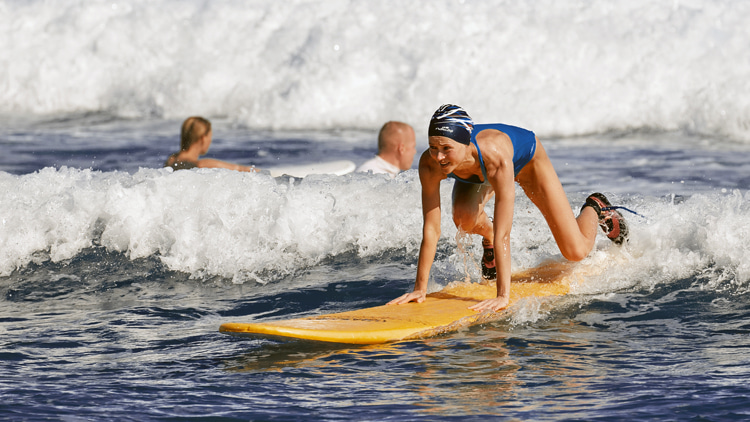
Soup Surfing and Currents
The broken part that rolls toward the shore is called the whitewater (or the soup).
Sometimes, the whitewater can dissipate, turn back into an unbroken swell, and break again.
Surfers call that reforming - some places reform all the time, and some rarely do.
You should make sure that you are surfing at a surf spot that is known by local surfers as a good place for learning.
Avoid breaking waves and concentrate the focus of your learning attention on gentle rolling whitewater waves that do not or only rarely reform and where the water is not too shallow.
Generally, at most easy beginner beach breaks where there is not too much current and very little undertow or rip tides, broken waves will turn into whitewater soup, and that's what you want to catch and ride.
Undertows and rip tides are caused by wave action pushing and accumulating excess water near the shore that rushes back out to sea in water currents.
If the currents moving out to sea are under the water, we call them undertows. If the currents are on the surface, we call them rip tides.
Stronger undertows and rip tides are often found when the waves are bigger, and the beaches are steeper.
Larger waves with steep beaches and uneven bottom contours contribute to the strength of undertows and rip tides.
If you ever find yourself caught in a strong undertow or rip tide, the common sense, widely known strategy to swim or paddle out of them is to move sideways to a different part of the beach where there is no undertow or rip tide and go in there.
Currents run in channels, so by moving sideways to a different portion of the beach, you can usually get out of the outgoing current and over to where the waves and the current will be moving toward the shore.
Experienced surfers learn how to spot rip tides at beach breaks and will use the outgoing current to paddle out to the breaking waves without having to push through the whitewater.
You can do the same thing while you are learning if you are surfing a place with small waves and, correspondingly, light rip tides.
A common beginner reaction to getting caught in a bad spot, whether it's being caught in a rip tide or being underwater after a wipeout, is to panic.
Panic, by itself, will rob you of the ability to think straight, and it will drain your energy level when you need it most.
Experienced surfers train themselves never to panic.
Whatever you need to do in any given situation in the water will become much more difficult if you panic.
If you are in the midst of a wipeout, you can hold your breath longer and move yourself to the surface much easier by staying relaxed.
If you need to paddle or swim out of a rip tide, you can evaluate and move out of it safely and more efficiently if you calmly do what's needed without panicking.
Telling you not to panic might seem easier said than done, but you can train yourself not to panic.
Just keep in mind, when you get in situations that might make you want to panic, that if you stay relaxed, you'll get through it stronger and easier than you would otherwise, and you might even have fun doing it.
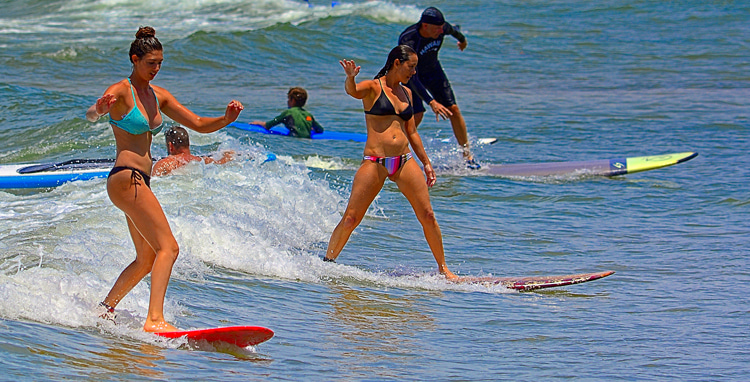
Hazards in Shallow Waters
One thing to be careful about in Southern California is stingrays. Their barbs can be very painful.
The way to avoid them is to keep an eye peeled for them and to shuffle and slide your feet in the sand when you wade in shallow, murky sandy water.
Do not lift your feet and step back down.
If you step on one, it will sting you. If you shuffle into it, it won't. It will swim safely away before you reach it.
Remember to do the stingray shuffle.
If you get stung by one, after you visit the lifeguard station for first aid, go home and soak the entry point in hot water and Epsom salts.
In Hawaii, sea urchins cover some parts of the reefs and rocks.
It is common knowledge among surfers that urinating on sea urchin barbs dissolves the barbs and any infection they may cause.
Still, it has to be done right away, preferably within half an hour of being pricked. Yes, that sounds gross and revolting, but I, the author, know about this firsthand.
It worked for me every time I stepped on sea urchins in Hawaii, the first time being when I was a teenager.
By the way, for your general knowledge, locals in Hawaii call sea urchins "wana."
You have your board, you've practiced paddling, and you have selected a good beginner wave, not too big, with lots of whitewater to learn on.
Now what?
The next step is to paddle your surfboard out far enough to where you can turn around and catch a whitewater wave, then ride the board in while lying down prone on your stomach.
Some breaks, like reef breaks, will have channels on each side of the breakers where there are no waves, and paddling out won't be difficult.
But most beginner waves are beach breaks where you will need to take the board out through the whitewater to where you can turn around and ride the wave in.
If that's the case and you are in California, shuffle your feet and watch out for stingrays on the way out.
If you are in Hawaii or other parts of the world, watch out for the sea urchins, the sharp reef, or whatever other local hazards you might have to deal with.
Spend a little time studying the place you intend to surf and check with lifeguards or other surfers before venturing out.
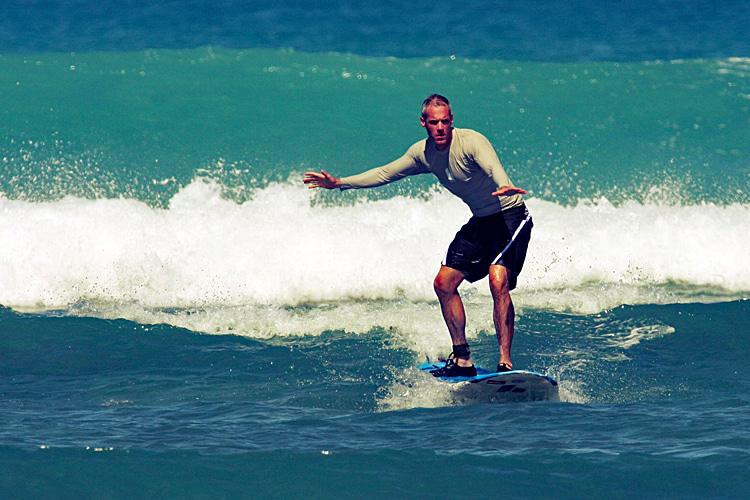
Getting Past the Whitewater
There are four main techniques to get out with your board through the whitewater.
One is to "turn turtle," or turtle roll, each time a wave hits you.
To turn turtle, you turn upside down in the water, and with your board above you, grasp the board by the sides near the front of the board - sides are called "rails" - and let the wave wash over you.
Turning turtle is an expert way to go through waves with a bigger surfboard.
Most beginners will find it difficult, but it doesn't hurt to try to learn how to do it in small waves.
Another technique, useful in very small surf, is to paddle through the wave or lift yourself on the board and let the wave wash between you and the board.
Paddling through the wave will be impossible in bigger surf.
The main basic beginner technique to get through waves that are too strong to paddle through and keep yourself and your board from getting dragged back to the beach is to get off your board, wrap your strong arm around the front of the board, and take it underwater with you each time a wave washes over.
You will still get dragged back a little on most normal-sized waves, but you won't get dragged as far back as you would if you tried to paddle through the wave.
Turtle rolling is the most effective technique, but it's also the most difficult to master, and you still have to flip the board over and get back on it to start paddling again each time you make it through a wave.
Another technique some experts use, if they know no one is behind them, is to let go of the board and let the leash bring it back.
I don't advise doing that, but it is effective because you can swim under the wave and counteract the drag on the board, which means you won't get dragged back as far as you would with the other techniques.
The problem with that is that you would be putting a strain on the leash; it could snap or come loose, and there could be someone behind you that you didn't see or who didn't notice that you let go of your board.
Most surfers aren't too happy with people who let go of their boards in front of them.
It can get you in a lot of trouble in the wrong circumstances, but if you are out by yourself and you're positive no one is behind you, and you're willing to risk damage to your leash, it's not a bad technique.
It does work, and in certain situations, even the best experts will let their boards go if they determine it's wise to do so.
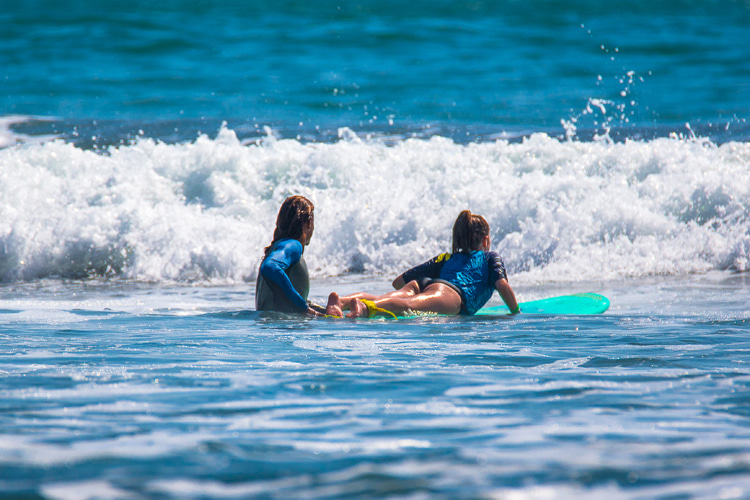
Timing Paddling and Waves
Each time you use one of the above techniques to get through a wave, you'll need to get back on your board, paddle toward the next incoming whitewater wave, and do it again.
You'll have to do it repeatedly, progressing a little at a time until you get out far enough to turn around and catch a whitewater wave in.
Ride the wave all the way into the sand or slide off and let the board go while it's safe to do so.
There are some places where you'll be able to stay on the board until the wave spends its energy and dies out.
If you come off the board and don't know where the board is, it's not a bad idea to go deep and slowly count to three, as my dad taught me when I was young.
Then, when you come up, if you're still unsure where the board is, cover your head or face, just in case, it's coming towards you.
You should experience a sense of heightened exaltation after you catch your first ride.
It may not seem as if they're going fast when you're watching a surfer's ride from the beach, but when you're the one on the wave, it seems like you're hauling ass.
Practice Is Progress
Now that you've caught your first wave, lying prone on your stomach, do it again five more times.
By the time you ride five more waves, you should find that you're getting better at getting out through the waves and turning around and riding in.
When you finish those five waves, ride one more wave in, but this time, while you're riding in, lean to the left to turn your board to the left, then lean to the right to turn your board to the right.
If you have trouble or fall off while leaning and turning your board, keep trying until you have it figured out.
Once you've done that, now take another ten more rides.
Make gentle turns back and forth on your first five rides, then start turning hard to the left and hard to the right all the way in on your last five rides.
By the time you finish riding those ten waves, you should be very competent at turning your board while riding the wave in lying prone on your stomach, and paddling back out and riding waves into the beach should not be too difficult for you.
If that's not the case, keep practicing until you feel comfortable with paddling in the ocean and catching the waves and how your board moves and turns on the way in.
Words by Roger Raffee | Surfer and Author of "How To Surf: From Beginner to Great Surfer in Just Three Weeks"
